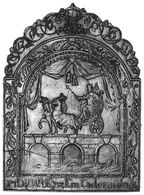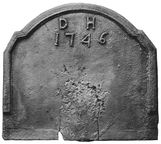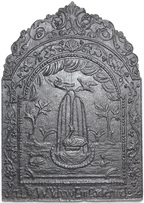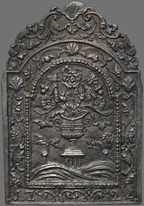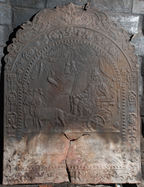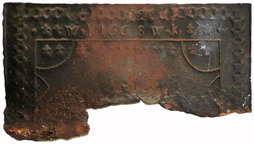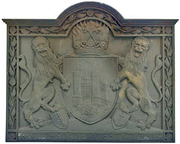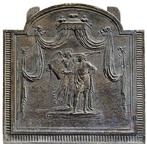-
238
Description: Arched rectangular shaped central panel with bead-and-pellet edging on a wide fillet; crowned figure, holding a sceptre in his right hand, sitting in a chariot drawn to the left by two, caparisoned horses with ostrich feather head-dresses; the whole upon a three-arched bridge with keystones and a string course, waves beneath; above, swagged drapery with two tassels hanging from the centre; arched rectangular shaped border with fillet edging, symmetrical, descending oak leaf and acorn branches, with a looped 'W' in each shoulder; inscription at base; on top, symmetrical scrolled plant tendrils and berries. A single central vertical plankline.
Notes: One of a series produced in the same year. All incorporate the looped 'W' motif which may be intended to identify the pattern maker. The design is derived from a personification of Europe, one of a set of playing cards entitled Jeu de la Géographie, designed by Stefano della Bella for Louis XIV. The inscription translates as 'God is our strength'.
Copies of this fireback are known.
Inscription: 17 DVW Ydyw Ein Cadernid 24
- Decoration tags:
- 'Dutch' (shape)
- fillet (edging)
- whole carved pattern
- planklines
- pictorial
- allegorical
- text
- animals
- humans
- objects
Manufactured: in 1724 in England.
Current location: Tredegar House, Pencarn Way, Duffryn, Newport, Gwent, Wales.
Museum number: F81.233 (part of the Welsh National History Museum museum group)
- Attached to series:
- 1724 series
- Welsh inscription series
- British 'Dutch' style firebacks
-
239
Description: Arched rectangle with stepped, canted shoulders; fillet and astragal edging (top and sides only); initials above date at top of plate.
Notes: The shape and edging are uncommon. Formerly from Caerphilly, Glamorgan.
Inscription: D H / 1746
- Decoration tags:
- rectangular with canted top corners and round arch (shape)
- fillet (edging)
- individual letters
- individual numbers
- text
Manufactured: in 1746 in Wales.
Current location: National History Museum, St Fagans, Glamorgan, Wales.
Museum number: 44.303/1 (part of the Welsh National History Museum museum group)
- Attached to series:
- Date & initials firebacks
-
240
Description: Arched rectangular shaped central panel with bead-and-pellet edging on a wide fillet; ground with birds, and trees behind; in the centre a circular fountain rim with a swan on a plinth surrounded by water, with jets of water rising from the swan’s mouth and descending on either side; above, a heron and a goose fly to the left; under the arch, swags of drapery; arched rectangular shaped border with fillet edging, symmetrical floral fronds descending from a scallop shell, top centre, with a looed 'W' in each shoulder; inscription at base between date; on top, symmetrical scrolled plant tendrils. A single central vertical plankline.
Notes: One of a group of firebacks, all of the same date, some of which have the same Welsh inscription which translates as 'God is our strength'. All incorporate the looped 'W' motif which may be intended to identify the pattern maker. The design is adapted from an illustration of fountain no. XXXIX, 'Les Cannes et le Petit Barbet' in Labyrinthe de Versailles by Sébastien le Clerc (1677); the flying heron and duck are copied from illustrations by Francis Barlow (c1626-1704) or from engravings of his work by Wenceslaus Hollar (1607-77).
Copies of this fireback are known.
Inscription: 17 DVW Ydyw Ein Cadernid 24
- Decoration tags:
- 'Dutch' (shape)
- fillet (edging)
- whole carved pattern
- planklines
- pictorial
- architectural
- text
- animals
- objects
Manufactured: in 1724 in England.
Current location: Newton House, Dinefwr, Llandeilo, Carmarthenshire, Wales.
Museum number: F83.116 (part of the Welsh National History Museum museum group)
Citation: Lloyd, N., 1925, 'Domestic Ironwork I', Architectural Review, 58, pp. 58-67.
- Attached to series:
- 1724 series
- Welsh inscription series
- British 'Dutch' style firebacks
-
1084
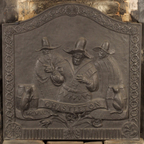 ? x ? mmImage subject to copyright
? x ? mmImage subject to copyrightDescription: Ogee-arched rectangular shaped central panel with fillet edging; pictorial scene with three figures dressed in clothing of the early 17th century, with wide-brimmed hats, the central figure to the fore and wearing doublet and belt, the two others in coats; across the bottom a trpartite scroll bearing the inscription CHASTLETON on the upper part, and the date MCMXCV and C of A (Charteris of Amisfield) & [illegible] R split between the lower parts, with three tulips beneath; resting on each outer part of the scroll, a barrel with a cat; an ogee-arched rectangular border with fillet edging with floral guilloche decoration and daisy flowers at the top and in the top corners; in the bottom left corner the circular badge of the National Heritage Memorial Fund, and in the bottom right corner the circular badge of the National Trust.
Notes: This fireback was cast for Martin, Lord Charteris of Amisfield (1913-99), Trustee of the National Heritage Memorial Fund, from a pattern he designed and made, to commemorate the 390th anniversary of the Gunpowder Plot; cast with figures associated with Robert Catesby, owner of a previous house on the site and one of the chief conspirators, and the cats belonging to the then owner, Mrs Barbara Clutton-Brock.
Inscription: CHASTLETON / MCMXCV / C of A & [?]R
- Decoration tags:
- rectangular with round arch (shape)
- fillet (edging)
- whole carved pattern
- pictorial
- text
- animals
- humans
- plants
- objects
Manufactured: in 1995 in England.
Current location: Chastleton House, Chastleton, Oxfordshire, England.
Museum number: 1430298 (part of the National Trust museum group)
- Attached to series:
- Martin Charteris firebacks
- Commemorative firebacks
-
874
Description: Arched rectangular central panel with ovolo linking curves and eyelet astragal edging; pictorial scene of Delilah, seated above a pavement, supervising the cutting of Samson's hair by a barber, a putto to the left and a small figure lower right; drapery above; arched rectangular border with ovolo linking curves and fillet edging; symmetrical pattern of plant tendrils with leaves and seed pods; at bottom, monogram 'EB' in a cartouche between symmetrical leaves and ears of wheat; on top, two mirrored sea serpents.
Notes: One of a small series of firebacks identified by the EB monogram; the pictorial scene is of Delilah and the sleeping Samson with a Philistine cutting his hair; the scene may be based on an engraving by the Dutch artist Philip Galle (1537-1612) after a painting by Maerten van Heemskerck.
Copies of this fireback are known.
Inscription: EB
Manufactured: in the late-17th to early-18th century in England.
Current location: Chastleton House, Chastleton, Oxfordshire, England.
Museum number: 1430205 (part of the National Trust museum group)
- Attached to series:
- EB series
- Old Testament & Apocrypha firebacks
- British 'Dutch' style firebacks
-
1032
Description: Arched rectangular shaped central panel with solid and hollow bead on fillet edging, grouped alternately in threes and twos respectively, on a wide fillet; on a Tuscan pedestal rising from waves, a narrow waisted, gadrooned flower vase with two scrolled handles and a horizontal banded decoration from which issue tendrils bearing flowers, berries and seed pods; arched rectangular shaped border with fillet edging, wide at the sides, symmetrical floral fronds descending from a scallop shell, top centre, with a scallop shell inside each shoulder; at base, date split between two looped 'W' figures; on top, symmetrical scrolled plant tendrils descending from a central scallop shell.
Notes: The third largest of six flower vase firebacks designed and made in the same year, larger ones of which include a religious inscription in Welsh. All incorporate the looped 'W' motif which may be intended to identify the pattern maker. Cheffins auction, Cambridge, 13 Jun 2018, lot 738 (£240).
Copies of this fireback are known.
Inscription: 17 24
Manufactured: in 1724 in England.
Current location: not known.
- Attached to series:
- 1724 series
- British 'Dutch' style firebacks
-
257
Description: Arched rectangular central panel with ‘nutshell’ edging on a broad fillet; crowned figure, holding a sceptre in his right hand, sitting in a chariot drawn to the left by two horses with ostrich feather head-dresses; the whole upon a causeway with pilasters and masonry, and waves beneath; a heron flying to the left; above, swagged drapery with two tassels hanging from the centre; arched rectangular shaped border with fillet edging, symmetrical, flower bunches, descending from a ribbon loop; monogram centre bottom, between plant tendrils; on top, symmetrical scrolled plant tendrils.
Notes: The design is derived from a personification of Europe, one of a set of playing cards entitled 'Jeu de la Géographie', designed by Stefano della Bella (1677); a similarity with Queen Anne may not be coincidental; the flying heron has been copied from a print by Wenceslaus Hollar c.1658.
Copies of this fireback are known.
Inscription: SHR
Manufactured: in the late-17th to early-18th century in England.
Current location: Chiddingstone Castle, Chiddingstone, Kent, England.
- Attached to series:
- SHR series
- British 'Dutch' style firebacks
-
1155
Description: Rectangular shape; fillet edging (top and sides); across the top, line of squared cross stamps in three groups (5, 5 and 7), with six more continued down each side; below the top line of stamps, central date with initials in triad to each side, interrupting the top line of stamps, with two fleurs-de-lys to each side and a single bead; below, three sides of a rectangular compartment, fillet edged with irregular quadrants at the top corner enclosing two fleurs-de-lys each, between which is a line of about 10 beads between single fleurs.
Notes: A large and badly corroded fireback linking the Square Cross series and Hollow Saltire series stylistically. The initials probably relate to a husband and wife. Chorley's Auctioneers sale, Gloucester, 20 November 2019, lot 634 (£20).
Inscription: WCK [triad] 1668 WCK [triad]
- Decoration tags:
- rectangular (shape)
- fillet (edging)
- simple stamps
- carved stamps
- individual letters
- individual numbers
- heraldic
- text
- objects
Manufactured: in 1668 in the Forest of Dean area of England.
Current location: not known.
- Attached to series:
- Newent area group
- Square cross Dean series 1
-
1178
Description: Arched rectangular shape; moulded top edge with undulating floriate border within fillets intersecting at the corners; in each corner a rose; along the bottom, the motto Multi Societate Tutiores - With many more safe; within the border, shield, supporters and crest
Notes: Blazon: Argent, upon a rock issuant from the base proper, inscribed 1824 in gold numerals, a quadrangular castle also proper, pennons flying to the sinister from each tower gules; crest: In front of flames proper issuant from a coronet of four roses argent, barbed and seeded proper, set upon a rim Or, two keys in saltire, wards upwards, sable; supporters: On the dexter side a lion guardant Or, resting the sinister hind leg on an escutcheon argent charged with a rod of Aesculapius gules, and on the sinister side a like lion resting the dexter hind leg on an escutcheon argent charged with an anchor sable. The Alliance Assurance Company was founded in 1824 and merged with the Sun Insurance Company in 1959. The arms were granted in 1933. An openwork version of this fireback (i.e. with the background voided) was formerly displayed outside its offices. Christie's auction, London, sale no.7006, 19 May 2005, lot 34 (£384).
Inscription: MVLTI SOCIETATE TVTIORES
Arms: Alliance Assurance Company
- Decoration tags:
- rectangular with round arch (shape)
- fillet (edging)
- whole carved pattern
- heraldic
- armorial
- text
Manufactured: in the early- to mid-20th century in England.
Current location: not known.
- Attached to series:
- Corporate firebacks
-
933
Description: Carved wooden fireback pattern. Arched rectangular shape with fillet and cavetto-moulded edging; a canopy with swagged drapery descending from ribbon bunches, beneath which stand two figures: behind, a female angelic figure, right breast exposed, blowing a trumpet held in her left hand and holding an arched rectangular shield in her right hand; in front, a classically dressed male figure wearing a face mask; slatted extensions to the side and bottom; two battens to the rear of the pattern, visible at the top.
Notes: The significance of the scene has not been identified. Christie's auction 3 Jul 2002 lot 160 (£588).
- Decoration tags:
- rectangular with round arch (shape)
- fillet (edging)
- whole carved pattern
- planklines
- pictorial
- architectural
- humans
Manufactured: in the mid- to late-18th century in France.
Current location: not known.
- Attached to series:
- Patterns
